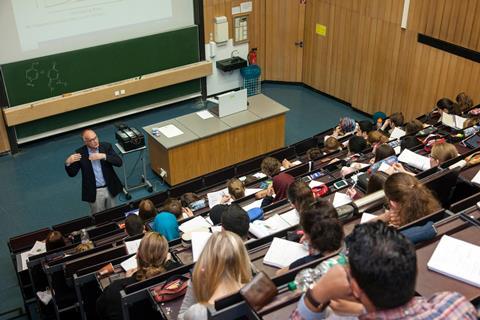Five tips for educating and inspiring university students

For Ben Lear, the most rewarding aspect of being an educator is helping students overcome various challenges. ‘When a student has been struggling to understand something, and you help them root out the source of their struggle, that’s the most satisfying [part],’ says Lear, a professor of chemistry at Pennsylvania State University in the US. Moreover, he says, teaching provides ‘a chance to practice explaining things’. After all, scientists have to explain the value of their research to their trainees and colleagues daily.
Here are some helpful suggestions for teaching chemistry in a way that helps students appreciate the subject and cultivate a genuine interest in it.
Make connections
Subhajit Bandyopadhyay, a professor of chemistry at the Indian Institute of Science and Education Research, Kolkata, says students need to understand why they are studying chemistry. ‘They need to relate this subject to their own lives,’ he says. Bandyopadhyay gives his students an open, graded assignment wherein they reflect on the connection between chemistry and their interests, such as football, cooking, and music. Such activities ignite students’ curiosity about chemical concepts and motivate them to explore their underlying basics.
Commit to improving
Be open to receiving feedback from your students. ‘Students don’t always know what’s best for them,’ says Gan Shermer, a senior lecturer and director of teaching in the chemistry department at the University of Bath, UK. ‘But they often have perfect ideas about things you could change. And sometimes, they struggle with things you wouldn’t even expect.’
You should also commit to keep slowly adding skills to your toolkit. ‘There are small changes you can make that make a big difference,’ says Ginger Schultz, an associate professor of chemistry at the University of Michigan, US. She keeps a teaching notebook, writing in it when something happens in the classroom that she wants to ponder later.
Cultivate students’ resilience
Identifying learning objectives for your class is crucial because it helps you ascertain what you want to teach and assess, says Marcy Towns, a professor of chemistry and interim head of the chemistry department at Purdue University, US. When students don’t meet those objectives, Towns suggests being gentle. ‘If you get a C on your first chemistry, calculus or biology exam, the message is not “you don’t belong here”. The message is, “Hey, we need to think about how we studied and what we need to do differently to be more successful”,’ she says. She and her teaching partner conduct exam de-briefs after every test and try to flesh out answers to the questions that most students got wrong. It’s a valuable exercise that helps students identify their weak areas.
Lear observes that approaching students’ issues with empathy may be vital in resolving them. ‘At the heart of good teaching is understanding what a student is experiencing,’ he says. For example, if a student is struggling with chemical equations, it’s essential to understand why they can’t get the hang of them before you jump into an explanation.
Infuse some fun
For several years, Neil Garg, a distinguished professor of chemistry at the University of California, Los Angeles, US, gave organic chemistry undergraduates a graded assignment that involved making music videos about chemical concepts and reactions they were studying in the classroom. ‘It was a simple realisation for me that if the students associate what they’re doing with fun, they enjoy learning,’ says Garg. ‘All of a sudden, it was less about studying for a test. It was studying to do this creative assignment.’
In-classroom demonstrations of lab-like chemistry experiments can also be a fun way to teach essential reactions. However, ‘there is a right and a wrong way to do it,’ says Scott Showalter, a professor of chemistry at Pennsylvania State University: ‘You have to be purposeful in inserting a demonstration, and the best way to do that is to make sure your demonstrations correlate with learning objectives.’ Students will benefit most from such an exercise if it’s interactive. Give students ample time to discuss the demo in groups and ask questions.
Challenge students to grow
Teaching shouldn’t just be about inundating students with facts, says Shermer: ‘It should also be about equipping them with the skills they can use, whatever they decide to do afterward’. These skills include teamwork and making presentations. It is also essential to give students projects that hone their problem-solving chops. Shermer likes to provide assignments dealing with real-life problems, where students work in teams and improve the design of drug molecules based on provided data.
Moreover, you need to ensure that students maximise their lab time. ‘One of the problems with practicals is that sometimes students come to it thinking that they’re just following a recipe,’ says Shermer, ‘so they’re not learning the chemistry.’ She gives pre-lab quizzes to make sure students are already thinking about the experiment’s theory when they come to the lab.

















No comments yet